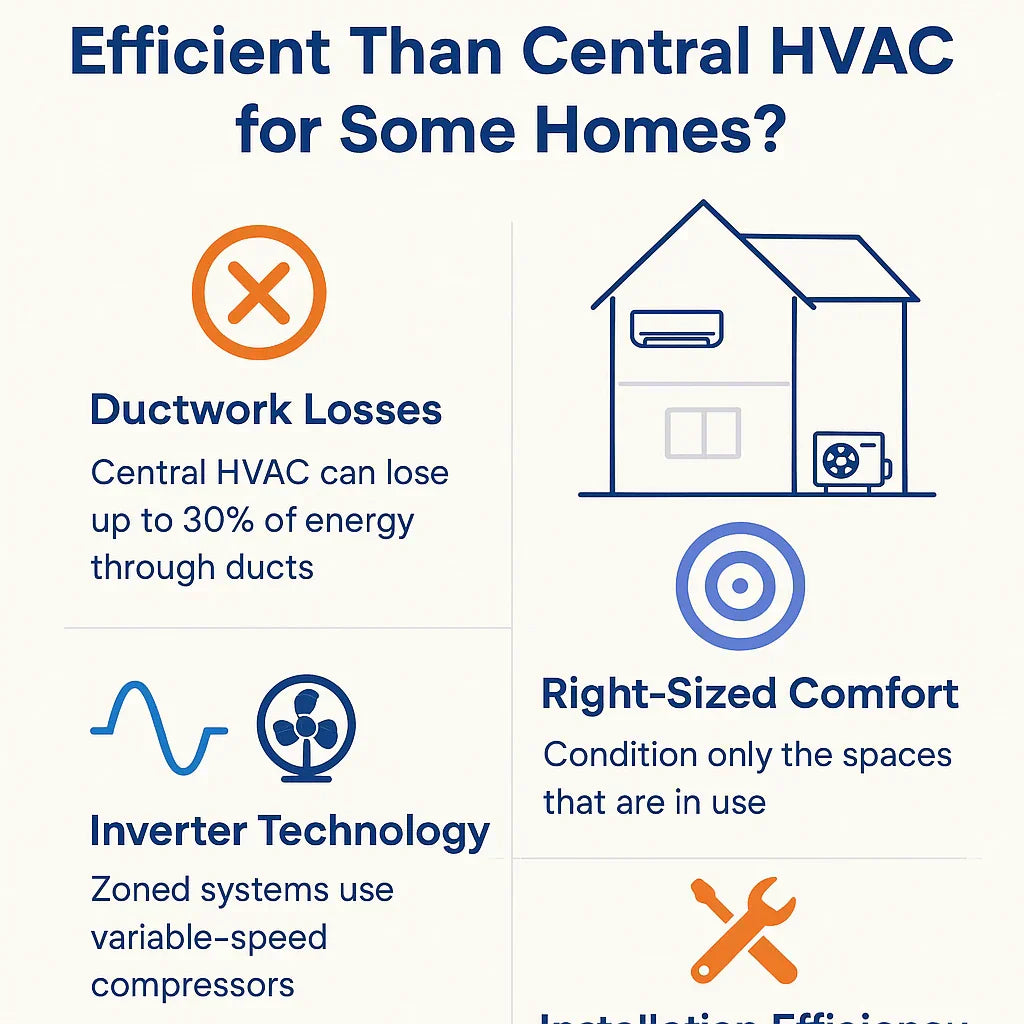If you're weighing the pros and cons of ductless vs. central HVAC, you may be surprised to learn that a 2-zone mini split system could outperform a traditional ducted system in both comfort and energy efficiency—especially for smaller homes, additions, and specific room-by-room needs. This deep dive explains why.
⛔️ Ductwork Losses: The Hidden Energy Drain
One of the biggest differences between a ductless 2-zone system and a central HVAC system is the absence of ductwork.
Why ducts waste energy:
-
According to the U.S. Department of Energy, ducts can leak up to 30% of conditioned air.
-
In older homes, duct systems are often routed through unconditioned spaces like attics and crawlspaces.
-
That means you're spending money to cool or heat air that never reaches its destination.
With ductless mini splits, there are no ducts. Air is conditioned directly in the room where it's needed, so there's virtually no transmission loss.
📌 Right-Sized Comfort: Only Condition What You Use
Central HVAC systems are designed to treat the whole house. That may seem like a good thing—until you realize how much energy is wasted on rarely used rooms.
A 2-zone system, on the other hand, lets you control only the rooms you need. For example:
-
Bedroom + Office combo: Keep the bedroom cool at night and the office comfortable during the day.
-
Living Room + Garage conversion: Treat high-usage areas without sending conditioned air to storage closets or unused guest rooms.
This targeted approach results in lower runtime, less electricity usage, and more personalized comfort.
⚛️ Inverter Technology vs. Single-Stage Compressors
Most modern mini split systems use inverter-driven compressors, which operate at variable speeds depending on demand.
Key Benefits of Inverter Compressors:
-
Adjust output in real-time for minimal energy use
-
Maintain more consistent indoor temperatures
-
Avoid energy spikes from starting/stopping cycles
In contrast, many central HVAC systems (especially older ones) use single-stage or two-stage compressors:
-
Single-stage = full blast or nothing
-
Two-stage = slightly better modulation, but still inefficient compared to inverter systems
Mitsubishi explains inverter technology as a way to "ramp up" and "dial down" like a dimmer switch, versus a simple on/off light.
💸 Energy Savings and Lower Utility Bills
By avoiding duct losses and using inverter modulation, 2-zone mini split systems often achieve 20% to 40% lower cooling costs compared to central HVAC in the same space.
Consider the Ratings:
-
Central HVAC: SEER 13–16 is common in older homes
-
Ductless Mini Split: SEER2 ratings of 20+ are now standard
ENERGY STAR estimates that ENERGY STAR-rated ductless systems can save an average of $875 annually on utility bills, depending on climate and usage.
🛎️ Easier and More Affordable Installation
Central HVAC installs often require:
-
Duct design or ductwork replacement
-
Ceiling/wall demolition for routing
-
Additional attic or crawlspace labor
Ductless 2-zone systems only need:
-
A small 3-inch wall opening
-
One outdoor condenser unit
-
Two wall-mounted (or ceiling-mounted) air handlers
This makes 2-zone systems ideal for:
-
Older homes with no ductwork
-
Room additions or garage conversions
-
Second floors where retrofitting is costly
You can save thousands of dollars in labor alone.
🌇 Climate Performance: Zoned Systems Handle Extremes Better
Let’s say your bedroom faces west and bakes in the afternoon sun, while your living room stays shaded and cool. A single central thermostat can’t manage both.
A 2-zone system lets you:
-
Run the bedroom zone harder in late afternoon
-
Leave the living room untouched
And in cold weather? Mini splits with hyper-heat functionality operate in temps down to -5°F or even lower.
Explore cold-climate options:
🪛 Air Quality and Allergen Reduction
Ducted systems can harbor:
-
Dust, dander, and mold spores
-
Debris buildup over time
-
Poor airflow due to dirty ducts or improper design
2-zone ductless systems:
-
Have built-in washable filters at each air handler
-
Offer HEPA or ionizer options in premium models
-
Improve localized airflow and comfort
The EPA notes that duct cleaning may not even solve these issues—which ductless avoids altogether.
⚖️ Maintenance and Long-Term Durability
Ductless systems are designed for modular simplicity:
-
No ducts to leak, seal, or insulate
-
Less stress on one system serving the entire home
-
Each air handler can be serviced independently
Central HVAC often relies on one big air handler or furnace that can fail and take down the whole system. With a 2-zone setup, if one indoor unit needs repair, the other can continue to run.
🧐 Smarter Zoning = More Control
Want your bedroom at 67°F but your living room at 74°F? Central HVAC can’t easily do that without expensive zoning systems.
2-zone ductless systems:
-
Come with remote or app-based controls for each zone
-
Allow precise temperature settings
-
Can be scheduled independently for different times of day
Perfect for households where people have different comfort preferences—or to manage heating/cooling based on when you use the space.
📅 Case Study: 2-Zone System in a 1,200 Sq Ft Bungalow
Before:
-
Aging 3-ton central HVAC system
-
Inconsistent cooling
-
Utility bills averaging $250/month (summer)
After:
-
Installed 2-zone mini split (12k + 18k BTU)
-
Zoned for living room and master bedroom
-
Summer bills dropped to $140/month
-
Noise reduced, air quality improved
✨ Final Verdict: When 2-Zone Mini Splits Are More Efficient
| Scenario | Winner |
|---|---|
| Older home, no ductwork | 2-Zone |
| Room addition or remodel | 2-Zone |
| High-efficiency whole-home need | Central HVAC |
| Personalized room-by-room temps | 2-Zone |
| Budget install | 2-Zone |
✅ Jake's Takeaway
"If you’re only using a few rooms and want total control without duct headaches, 2-zone is a no-brainer."
In the next topic we will know more about: DIY-Friendly? What Jake Needs to Know Before Installing a 2-Zone Mini Split







